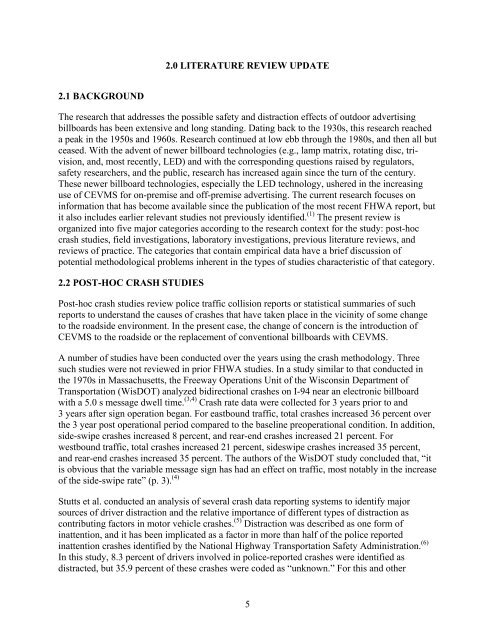The Effects of Commercial Electronic Variable Message Signs ...
The Effects of Commercial Electronic Variable Message Signs ...
The Effects of Commercial Electronic Variable Message Signs ...
You also want an ePaper? Increase the reach of your titles
YUMPU automatically turns print PDFs into web optimized ePapers that Google loves.
2.1 BACKGROUND<br />
2.0 LITERATURE REVIEW UPDATE<br />
<strong>The</strong> research that addresses the possible safety and distraction effects <strong>of</strong> outdoor advertising<br />
billboards has been extensive and long standing. Dating back to the 1930s, this research reached<br />
a peak in the 1950s and 1960s. Research continued at low ebb through the 1980s, and then all but<br />
ceased. With the advent <strong>of</strong> newer billboard technologies (e.g., lamp matrix, rotating disc, trivision,<br />
and, most recently, LED) and with the corresponding questions raised by regulators,<br />
safety researchers, and the public, research has increased again since the turn <strong>of</strong> the century.<br />
<strong>The</strong>se newer billboard technologies, especially the LED technology, ushered in the increasing<br />
use <strong>of</strong> CEVMS for on-premise and <strong>of</strong>f-premise advertising. <strong>The</strong> current research focuses on<br />
information that has become available since the publication <strong>of</strong> the most recent FHWA report, but<br />
it also includes earlier relevant studies not previously identified. (1) <strong>The</strong> present review is<br />
organized into five major categories according to the research context for the study: post-hoc<br />
crash studies, field investigations, laboratory investigations, previous literature reviews, and<br />
reviews <strong>of</strong> practice. <strong>The</strong> categories that contain empirical data have a brief discussion <strong>of</strong><br />
potential methodological problems inherent in the types <strong>of</strong> studies characteristic <strong>of</strong> that category.<br />
2.2 POST-HOC CRASH STUDIES<br />
Post-hoc crash studies review police traffic collision reports or statistical summaries <strong>of</strong> such<br />
reports to understand the causes <strong>of</strong> crashes that have taken place in the vicinity <strong>of</strong> some change<br />
to the roadside environment. In the present case, the change <strong>of</strong> concern is the introduction <strong>of</strong><br />
CEVMS to the roadside or the replacement <strong>of</strong> conventional billboards with CEVMS.<br />
A number <strong>of</strong> studies have been conducted over the years using the crash methodology. Three<br />
such studies were not reviewed in prior FHWA studies. In a study similar to that conducted in<br />
the 1970s in Massachusetts, the Freeway Operations Unit <strong>of</strong> the Wisconsin Department <strong>of</strong><br />
Transportation (WisDOT) analyzed bidirectional crashes on I-94 near an electronic billboard<br />
with a 5.0 s message dwell time. (3,4) Crash rate data were collected for 3 years prior to and<br />
3 years after sign operation began. For eastbound traffic, total crashes increased 36 percent over<br />
the 3 year post operational period compared to the baseline preoperational condition. In addition,<br />
side-swipe crashes increased 8 percent, and rear-end crashes increased 21 percent. For<br />
westbound traffic, total crashes increased 21 percent, sideswipe crashes increased 35 percent,<br />
and rear-end crashes increased 35 percent. <strong>The</strong> authors <strong>of</strong> the WisDOT study concluded that, “it<br />
is obvious that the variable message sign has had an effect on traffic, most notably in the increase<br />
<strong>of</strong> the side-swipe rate” (p. 3). (4)<br />
Stutts et al. conducted an analysis <strong>of</strong> several crash data reporting systems to identify major<br />
sources <strong>of</strong> driver distraction and the relative importance <strong>of</strong> different types <strong>of</strong> distraction as<br />
contributing factors in motor vehicle crashes. (5) Distraction was described as one form <strong>of</strong><br />
inattention, and it has been implicated as a factor in more than half <strong>of</strong> the police reported<br />
inattention crashes identified by the National Highway Transportation Safety Administration. (6)<br />
In this study, 8.3 percent <strong>of</strong> drivers involved in police-reported crashes were identified as<br />
distracted, but 35.9 percent <strong>of</strong> these crashes were coded as “unknown.” For this and other<br />
5

















